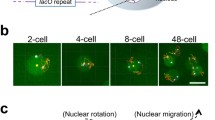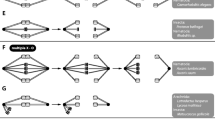Conclusion
While the cause of the differential behaviour is not known we can with some confidence specify the conditions affecting its consequences. In the first place particular chromosomes respond to the abnormal conditions within the cell in different ways. InScilla it was shown that long chromosomes were more frequently retarded than short ones. A specific chromosome response was also deduced byJain inLolium, from the disproportionate preponderance of unsynchronised cells with one or two advanced bivalents. This kind of specificity may or may not be simply related to length, for example the minimum requirements for condensation may be greater for longer chromosomes. There is no evidence either way.
A second condition, along with the first, would certainly appear to be the spatial relations of chromosome material within the nucleus, a factor recently discussed in general terms byDarlington (1957). On this basis the abnormal cells could be regarded as containing nuclei where co-operation was restricted, uncharacteristically, over limited distances. As suggested earlier the initial cause of this is most reasonably attributed to differences in the cytoplasm, which in normal cells permits general co-operation within nuclei, but which in abnormal cells with genetically identical nuclei, does not.
Similar content being viewed by others
Bibliography
Darlington, C. D.: Recent Advances in Cytology, 2nd ed. London: Churchill 1937.
—: Messages and movements in the cell. In: Conference on Chromosomes, p. 1–33. Zwolle, The Netherlands, 1957.
Jacobsen, W., andM. Webb: The two types of nucleo-proteins during mitosis. Exp. Cell Res.3, 163–183 (1952).
Jain, H. K.: Effect of high temperature on meiosis inLolium: nucleolar inactivation. Heredity11, 23–36 (1957).
La Cour, L. F.: Heterochromatin and the organisation of nucleoli in plants. Heredity5, 37–50 (1951).
Lin, M.: Chromosomal control of nuclear composition in maize. Chromosoma7, 340–370 (1955).
Author information
Authors and Affiliations
Rights and permissions
About this article
Cite this article
Rees, H. Differential behaviour of chromosomes in Scilla. Chromosoma 9, 185–192 (1957). https://doi.org/10.1007/BF02568074
Received:
Issue Date:
DOI: https://doi.org/10.1007/BF02568074




